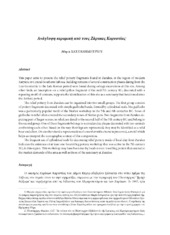Ανάγλυφη κεραμική από τους Ζάρακες Καρυστίας
Chapter
Permanent lenke
https://hdl.handle.net/1956/24185Utgivelsesdato
2017Metadata
Vis full innførselSamlinger
Sammendrag
This paper aims to present the relief pottery fragments found in Zarakes, in the region of modern Karystia in Central-Southern Euboea. Building remains of several construction phases dating from the Late Geometric to the Late Roman period were found during salvage excavations at this site. Among other finds, an inscription on a relief pithos fragment of the mid-7th century BC, decorated with a repeating motif of centaurs, supports the identification of this site as a sanctuary that functioned since the Archaic period. The relief pottery from Zarakes can be organized into two small groups. The first group consists of pottery fragments decorated with simple guilloche bands, formed by cylindrical seals. The guilloche was a particularly popular motif of the Naxian workshop in the 7th and 6th centuries BC. Rows of guilloche in relief often covered the secondary zones of Naxian pots. Two fragments from Zarakes depicting part of larger scenes, in relief, are dated to the second half of the 7th century BC and belong to the second group. One of these fragments belongs to a circular clay plaque decorated with two animals confronting each other. Based on the way their legs are represented, they may be identified as a wild boar and a lion. On another sherd a representation of a warrior with a horse is preserved, a motif which helps us interpret the iconographic context of this composition. The frequent use of cylindrical seals for decorating relief pottery made of local clay from Zarakes indicates the existence of at least one flourishing pottery workshop that was active in the 7th century BC, in this region. This workshop may have been run by local or even travelling potters that catered to the market demands of the area as well as those of the sanctuary at Zarakes.
